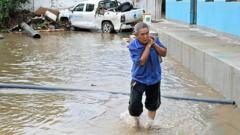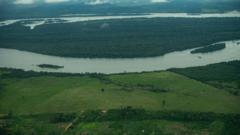China's Motuo Hydropower Station is set to become the world's largest but lacks transparency about its impact and details.
**China's Ambitious Motuo Hydropower Project Sparks Regional Concerns**

**China's Ambitious Motuo Hydropower Project Sparks Regional Concerns**
China's impending hydropower dam in Tibet may dwarf the Three Gorges Dam but raises alarms for neighboring countries and environmentalists.
In a move that could redefine global hydropower capabilities, China is poised to commence construction on the Motuo Hydropower Station in Tibet, a project anticipated to yield three times the electricity of the well-known Three Gorges Dam. Positioned in a seismic hotspot, this enormous endeavor presents a myriad of worries not only for environmentalists but also for nations downstream, particularly India and Bangladesh.
China's government has asserted that the construction of the Motuo dam is integral to its clean energy goals, alongside serving as a potential stimulus for the economy. Despite these ambitious claims, scant information has emanated from Beijing regarding the details of the initiative, leaving many questions unanswered. This secrecy includes fundamental aspects such as project funding, the companies involved, and potential displacements of local populations.
Constructed in Medog County, the dam will harness the Yarlung Tsangpo River, which transforms into the Brahmaputra River in India and the Jamuna River upon entering Bangladesh. The site is characterized by a dramatic elevation change, as the river plummets about 6,500 feet within a span of roughly 30 miles. Environmental critics warn that the dam could exacerbate seismic risks in an already vulnerable region and potentially disrupt water resources in neighboring countries.
As the Motuo project progresses, it remains crucial for the Chinese government to address these concerns and provide greater insight into the implications of such a monumental infrastructure undertaking.
China's government has asserted that the construction of the Motuo dam is integral to its clean energy goals, alongside serving as a potential stimulus for the economy. Despite these ambitious claims, scant information has emanated from Beijing regarding the details of the initiative, leaving many questions unanswered. This secrecy includes fundamental aspects such as project funding, the companies involved, and potential displacements of local populations.
Constructed in Medog County, the dam will harness the Yarlung Tsangpo River, which transforms into the Brahmaputra River in India and the Jamuna River upon entering Bangladesh. The site is characterized by a dramatic elevation change, as the river plummets about 6,500 feet within a span of roughly 30 miles. Environmental critics warn that the dam could exacerbate seismic risks in an already vulnerable region and potentially disrupt water resources in neighboring countries.
As the Motuo project progresses, it remains crucial for the Chinese government to address these concerns and provide greater insight into the implications of such a monumental infrastructure undertaking.



















